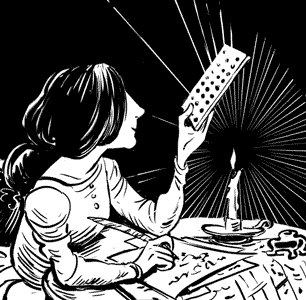Born Ada Gordon on December 10, 1815, Ada Lovelace was the daughter of the "mad, bad and dangerous to know" poet Lord Byron. Her mother, not wanting Ada to inherit her father's "poetic" temperament, immersed her in the study of science, logic and mathematics.
In 1833, she was introduced to Charles Babbage, a celebrated and somewhat infamous mathematician known for his unfinished clockwork like calculating machines. In 1842, Ada would expand on an article about Babbage's Analytical Engine, thus ensuring her place in history as the first "computer programmer." Babbage and Lovelace remained lifelong friends up until her death at age 36. Babbage described her as “that Enchantress who has thrown her magical spell around the most abstract of Sciences and has grasped it with a force which few masculine intellects could have exerted over it."
The Thrilling Adventures of Lovelace and Babbage: In this fantastic graphic novel, the Difference Engine is built and a pipe-smoking Lovelace and Babbage team up to fight crime, solve an economic crisis and cure the world of spelling errors…all while entertaining the Queen as well. The extensive footnotes rival those penned by Lovelace herself, and include historical curiosities and never-before-seen diagrams of Babbage's mechanical, steam-powered computer.
Ada's Algorithm: Behind every great man, there's a great woman; no other adage more aptly describes the relationship between Charles Babbage, the man credited with thinking up the concept of the programmable computer, and mathematician Ada Lovelace, whose contributions, according to author James Essinger, proved indispensable to Babbage's invention. The Analytical Engine was a series of cogwheels, gear-shafts, camshafts and power transmission rods controlled by a punch-card system based on the Jacquard loom.



Add a comment to: Ada Lovelace: “The Enchantress of Numbers”